The Effect of Titanium Oxide Nanotubes on the Surface Hardness of a Three-Dimensional Printed Denture Base Material
Abstract
Background: In the field of dentistry, there has been a growing prevalence of digital manufacturing technologies in recent years. Presently, the manufacturing of removable complete dentures using three-dimensional printing can be achieved through the utilization of computer-aided design and computer-aided manufacture (CAD-CAM) technology. This technology combines additive and subtractive techniques, commonly referred to as fast prototyping and three-dimensional printing, and employs PMMA professional light-curing resin as the material. The objective of this study is to assess the impact of titanium oxide nanotubes on the hardness of the underlying material utilized in 3D printed dentures. Materials and methods: The specimens were generated using 3D builder software developed by Microsoft Corporation, utilizing computer-aided design techniques. Specimens were designed with particular dimensions in compliance with the test standards for hardness. The denture resin 3D printed with titanium oxide nanotubes (Howngue, China TiO2 / D: 15-30 nm / L: 2-3 nm) was categorized into five groups (group 1 - 1% / group 2 - 1.5% / group 3 - 2% / group 4 - 2.5% / group 5 - 3%) based on weight. The specimens were printed using the Asiga max 3D printer, which utilizes digital light processing technology and is manufactured in Australia. Results: The average hardness values for the groups reinforced with 1% by weight of titanium oxide nanotubes showed a significant increase compared to the control group and with 1.5 % showed no significant difference. In contrast, the values for the other reinforcement groups declined considerably. Conclusion: The hardness of denture bases made from three-dimensionally printed material was successfully increased by including titanium nanotubes at concentrations of 1% by weight.
Downloads
Copyright (c) 2024 (Humanities, social and applied sciences) Misan Journal of Academic Studies

This work is licensed under a Creative Commons Attribution-NonCommercial-NoDerivatives 4.0 International License.
The copyright is also the copyright of the magazine only.
All articles published in our magazine are subject to license terms
Creative Commons Attribution(CC BY-NC-ND 4.0) This license permits the content to be reproduced, redistributed and reused in whole or in part for any purpose free of charge, without any permission from the author(s), researcher or student.
Works submitted to Maysan Journal of Academic Studies for publication in the journal (CC BY-NC-ND 4.0) license terms. Where available content can be shared, distributed and replicated provided there is no commercial profit and appropriate credit must be given to the original source through sources or citations. It is mandatory to review any material used from other sources including shapes, tables, and images for re-use under the terms of the Creative Commons License (CC BY-NC-ND 4.0).Provided that there is no modification to the original content



